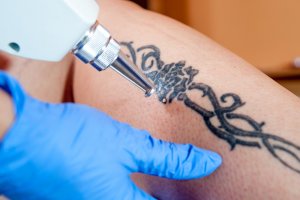
Tattoo placement is something you think about when you get a tattoo, but you probably don’t think about it if you are considering laser tattoo removal.
Some areas on the body are ideal tattoo locations, but they can be the worst for getting tattoos removed. Thus, tattoo placement matters when getting your ink removed.
Here is what you can expect as a cosmetic laser technician in the medical aesthetics industry!
Here are three reasons tattoo placement matters to trained cosmetic laser techs in the laser tattoo removal industry:
- Some locations are better for removal than others. When it comes to tattoo removal effectiveness, some tattoo placements are better than others. As a general rule of thumb, the closer a tattoo is to the heart, the more effective the treatment will be. Tattoos on the upper arms, neck or face have a better chance of removal as opposed to tattoos on the hands, feet or legs, which experience lower rates of circulation.
- Tattoo placement affects the number of sessions needed. An upper body tattoo may experience faster healing between each treatment session. Many laser techs suggest clients with upper and middle body tattoos wait about six to 12 weeks between sessions. For the lower body, it’s best to wait eight to 12 weeks between sessions.
- Tattoo placement impacts pain. It’s easy to guess some of the most painful tattoo locations. These same areas on the body can be quite painful for tattoo removal. The areas where this treatment tends to hurt the most include areas with thin skin, close to ligaments and bone, and areas on the body most people find sensitive.
How Does Tattoo Removal Work?
Before lasers became popular in the late 1980s, tattoo removal involved several methods that were often painful and scar-inducing. These methods included:
- Dermabrasion. Skin is “sanded” to remove the surface and middle layers of skin.
- Cryosurgery. The area is frozen before removal.
- Excision. A dermatologic surgeon removes the tattoo with a scalpel, and the wound is closed with stitches.
So how does tattoo removal work? The laser tattoo removal process is administered through a series of four to 10 cosmetic laser treatments. The tattoo pigment absorbs short pulses of intense light, which cause the ink to break down and be absorbed by our immune system.
After a treatment, the tattoo ink is recognized as waste within the lymphatic system and is excreted through the body’s natural immune system.
Tattoo Removal Training at National Laser Institute
At National Laser Institute, we offer tattoo removal training that can be completed in just one week!
During our Just Tattoo Removal Course, you will receive didactic education and clinical hands-on training where you will have to opportunity to treat scheduled clients in a medical spa setting.
The technology we use includes all three wavelengths (1064/755/532) to address all tattoo colors. Although most laser tattoo devices don’t include all three wavelengths, knowing the different types is key to your success as a tattoo removal technician.
Attendees who have received tattoo removal training have gone on to work at laser clinics, medical spas, tattoo shops, and some have even opened their own business!
Of course, if you are interested in learning more than just tattoo removal, our Comprehensive Laser Course has got you covered. In addition to tattoo removal, you’ll learn things like laser hair removal, skin tightening, acne reduction and IPL photofacial.
If you would like more information about cosmetic laser education courses, fill out the form on your right or give us a call at 1-800-982-6817.






































